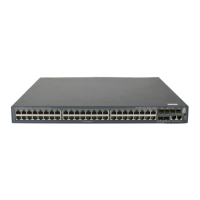148
Ste
Command
Remarks
3. Specify a source IP address
for outgoing portal packets.
portal nas-ip { ipv4-address | ipv6
ipv6-address }
Optional.
By default, no source IP address is
specified for outgoing portal
packets and the IP address of the
user logon interface is used as the
source IP address of the outgoing
portal packets.
In NAT environments, HP
recommends specifying the
interface's public IP address as the
source IP address of outgoing
portal packets.
Configuring portal stateful failover
Only Layer 3 portal authentication supports this feature.
To implement stateful failover for portal, configure VRRP for traffic switchover, and perform the following
configurations for service backup on each of the two devices that back up each other:
• Specify an interface for backing up portal services, which is called portal service backup interface
in this document, and enable portal on the portal service backup interface.
• Specify the portal group to which the portal service backup interface belongs. Be sure to specify the
same portal group for the portal service backup interfaces that back up each other on the two
devices.
• Specify the device ID. Make sure that the device ID of the local device is different from that of the
peer device.
• Specify the backup source IP address for RADIUS packets to be sent as the source IP address for
RADIUS packets that is configured on the peer device, so that the peer device can receive packets
from the server. (This configuration is optional.)
• Specify the backup VLAN, and enable stateful failover. For related configuration, see High
Availability Configuration Guide.
After the working state of the two devices changes from independence to synchronization and the portal
group takes effect, the two devices start to back up the data of online portal users for each other.
The AAA and portal configuration must be consistent on the two devices that back up each other. For
example, you must configure the same portal server on the two devices.
To configure stateful failover:
Ste
Command
Remarks
1. Enter system view.
system-view N/A
2. Enter interface view.
interface interface-type
interface-number
N/A

